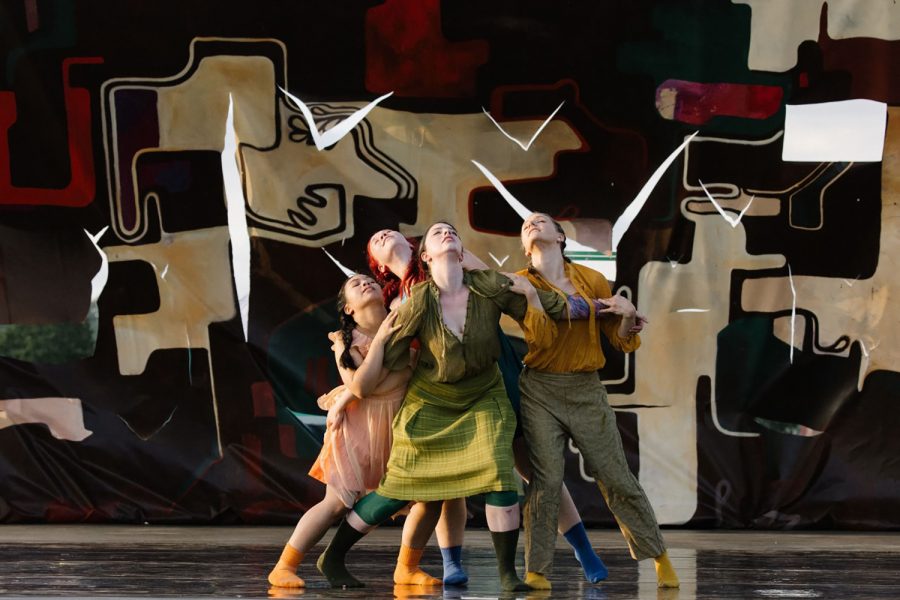Iowa City’s 17th annual dance festival to debut immersive, inclusive performances
Iowa City will celebrate its 17th annual dance festival Oct. 7-8. The festivities consist of three different events: a dance installation at Public Space One, a free and open dance at Chauncey Swan Park, and a dance show at the James Theater.
October 4, 2022
Bridging the rift between art forms, artists, and audiences, the Iowa City 2022 Dance Festival plans to showcase diversity and inclusivity throughout its two-day celebration.
The 17th annual festival is co-directed by Nora Garda and Eloy Barragán. Their nonprofit organization, InterDance, will sponsor the event. InterDance is committed to making dance accessible and important to Iowa City through the festival, workshops, and master classes.
This year, the festival will feature three events over the course of two days.
The first is a dance installation on Friday night at Public Space One Close, which is arguably the most unconventional of the three. Fifteen artists will simultaneously present while they are in the process of creating their work.
Garda is a dancer and a dance instructor. She described dance installations as living exhibits.
“It is like going to a museum when you have everything there,” Garda said. “But instead of being a painting on the wall only you, there will be stations with different things.”
Barragán is a University of Iowa associate professor of dance and a professional dancer.
“The audience can go through the whole experience in their own time,” Barragán said.
The event consists of a stunning diversity of exhibits.
“The interesting part of PS1 Friday night is you have live performers and musicians, you have digital performances, you have interactive performances,” Barragán said.
Still, some artists plan to present dance conventionally and instead focus their experimentation on the blend of different dance forms.
“We have the Quad City Ballet that is classical based,” Barragán said. “They also do contemporary and original work – not always traditional, classical repertory. We also have several improvisational groups and also groups of contemporary dancers.”
Other performers will expand peoples’ notion of dance by experimenting with incorporating movement into visual and performing arts.
“For example, we have a work with choreography of movement connected at the same time with visual arts,” Barragán said. “He is moving, but at the same time, creating something with chalk. You experience the music that he is creating and you will see the outcome of a painting.”
Another example is Sandy Dias, a photographer and video maker.
“They [Dias] have the component of being connected to movement,” Garda said. “But she is not in particular a dancer; she is an intermedia artist specializing in photography and videos.”
Nothing as experimental as this festival has been hosted in Iowa City before, said Barragán.
“So, we have decided to go full blast,” Barragán said. “In these times after the pandemic, I think people need the connections, the interaction with people.”
The novel format of the dance festival is also an endeavor to adapt to an artistic landscape transformed by the pandemic.
“Who thought in 2018 that dance can be taught on screen and with everybody at different locations?” Barragán asked. “That kind of thinking outside of the box is one good thing that happened during the pandemic. To maintain continued thinking outside of the box, we have invited the collaborations of all these people.”
The newly-opened PS1 mansion, where the event is taking place, is a spectacle well worth checking out — in fact, it’s what inspired the directors to innovate while organizing Friday night’s event. Just as the directors are featuring artists with diverse portfolios, they are also working toward including people with different levels of abilities in the celebrations. For instance, Sarah Furnish, one of the performers at the installation, is a certified danceability instructor.
“Danceability is a dance technique for people with and without disabilities to move and dance together,” Furnish said.
Furnish hopes to not only expand the art form, but also to make society more inclusive for people with disabilities.
“One thing I have found very interesting from meeting different organizations that do this work is that kids who went there their entire life, this is just part of their life,” Furnish said. “It is a real advantage that a young person can envision inclusion in dance because dance typically is very exclusive. This is to be able to re-envision bringing more people into something that is not only physically healthy but also spiritually so.”
Saturday afternoon’s free and open event enables artists like Furnish who are passionate about societal justice to directly impact people with their work.
The directors of the festival are mindful of the economic disparities characterizing Iowa City’s population. These won’t stand in the way of anybody’s participation in this year’s dance festival.
“One of the things that we are trying to do is to bring the arts to the people,” Barragán said. “We are trying to be inclusive because sometimes, even if the ticket is only $10, some people cannot afford it. They don’t have to worry; they can bring the entire family — especially with the economy now post-pandemic.”
The final event of the dance fest on Saturday night will be more like a traditional dance show, and the directors are aware of the popularity of these events.
“There are many people who like the conventional dance performance, and they can go to that at the theater,” Barragán said. “We want everybody to be able to find at least one thing they enjoy at the festival.”














